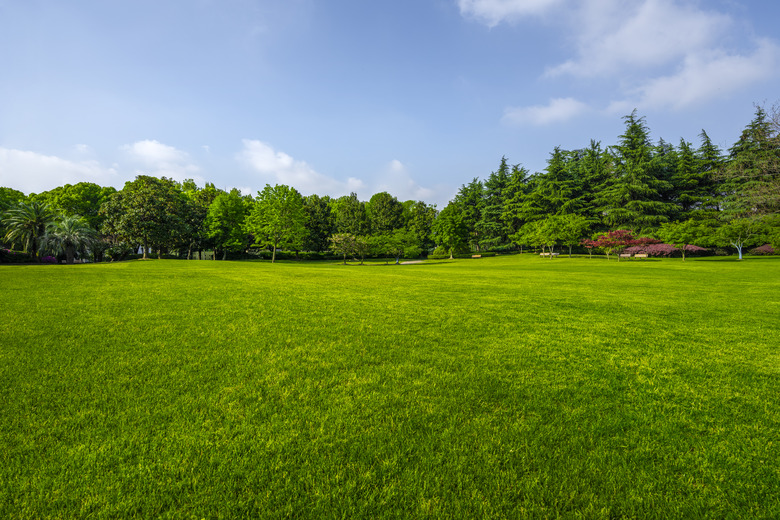How To Take Soil Samples Of Your Lawn For Testing
Whether you're getting ready to reseed your lawn or you find yourself wrestling with problem turf areas, taking soil samples can help you solve these issues. Soil testing will reveal the soil pH and let you know if your soil is missing key nutrients that grass needs to be lush and healthy. Soil test results will also let you know if the soil contains excesses of some nutrients, which can be as bad a problem as nutrient deficiencies.
Lab vs. DIY Soil Testing
Many colleges and universities run agricultural cooperative extensions that will test your soil for you. They typically charge a testing fee, but generally the price is nominal and well worth the expense.
If you prefer a more hands-on approach or want to cut costs, you can buy a soil test kit at your local hardware store for around $20 and test the lawn yourself. Self-testing will provide you with quicker results since you can conduct the test yourself rather than waiting for the lab. You may find, however, that self-test kits are not as extensive or reliable as university soil labs. Either way, the process of obtaining the sample is the same. Some test kits come with a soil probe to make sample collecting easier, but a garden trowel will do the job just as well.
How to Take Soil Samples of Your Lawn for Testing
1. Wait for the Right Time to Take a Soil Sample
Technically, you can take soil samples from your yard any time that the soil is dry and the ground is warm enough to obtain a sample. But it's generally to take a soil sample early in the spring before the recommended time in your area for turfgrass fertilization. This gives you adequate time to address and repair any soil deficiencies or excesses before the growing season starts in earnest.
If you've already fertilized your lawn, wait eight weeks before procuring a soil sample from it. Testing recently fertilized soil will skew your test results by adding nutrients to the soil that may not be there naturally. You'll get much more accurate information if you don't sample within eight weeks of fertilizing.
If the conditions in your lawn are fairly universal, pick 10 random areas to sample. The soil pH and nutrient levels are probably the same throughout your lawn. Your soil may be different in different areas, however. If it is, make sure you take samples from diverse sites.
Part of your lawn, for example, may lie next to a small creek. Another area may receive more shade than the rest of the lawn or may see more traffic. The soil in these areas may test differently than the rest of the lawn. Keep this in mind when taking samples and clearly label them. In this instance, gather as many samples as you need to test all of the different conditions in your lawn.
It's also a good idea to test the soil around the dripline of any trees on your property. Plants feed heavily along this line and could be pulling resources from the soil, stealing it away from your grass.
Whether you're using a trowel or a soil probe, wipe it down with a clean towel and a little denatured alcohol. This ensures that you don't accidentally contaminate your soil and skew the soil test results.
To take a soil sample, dig a narrow hole 6 to 8 inches deep in your lawn, reserving the soil and removing the turf, roots, and thatch. Repeat this process to secure a sample from all 10 of your chosen test sites, mixing all the samples together in a bucket or bowl.
The test lab or sample kit you're using will contain vials, bags, or other containers. Simply place the quantity of soil in these containers per the test kit directions and then send them or drop them off at the test lab you've chosen. Fill the holes you dug in your lawn with the leftover soil.
Usually, the lab testing your soil will instruct you to combine all the soil samples you took into a bucket or bowl and then send a single sample for analysis. If you want to know specifics about different areas of your lawn, however, you may need to send more than one sample and pay for more than one test. You should not mix soils of different colors or textures nor should you mix samples from vastly different elevations.
When you need a general overview of your lawn's overall health, combining multiple soil samples into one works well. If you think different parts of your lawn need different types of help, however, consider multiple soil tests. In this case, label each sample with a number and write down where you took the sample so you can keep track of your results.
If you've sent your sample to a lab for soil testing, they will mail or email your results in a few weeks. If you test the soil yourself with a home test kit, you'll have answers immediately. Often, the lab results or test kit will explain to you what your test results mean, but you could have to do a little interpreting on your own.
Ideally, the soil pH for most turfgrass types should be around 6.5, although some turfgrass species prefer pH levels above or below this reading. Determine your lawn's optimal pH by the type of turf you're growing. If the soil pH is higher or lower than the optimal range, add some amendments to raise or lower your pH and get closer to this goal.
Soil nutrients are measured in parts per million (ppm). For lawn growth, typically you want a phosphorous level between 15 and 50 ppm and a potassium level of 200 to 300 ppm.
If necessary, you'll need to adjust your pH level or fertilization techniques as indicated by your soil testing results. To lower soil pH, apply elemental sulfur for a healthy lawn. If you need to raise your pH to amend acidic soil, apply agricultural lime to your soil.
Till in any soil amendments needed to raise or lower pH. This is easy if you're preparing to seed a new lawn but impractical if your lawn is already established. In this case, you can apply amendments to the top of the soil and water them in. This method takes longer, however, and you may not see an improvement in your lawn immediately.
Deficiencies in magnesium, calcium and other nutrients are easily corrected with fertilizers or foliar sprays. Whatever additions are necessary for your soil, always follow the directions on product labels. Misusing chemicals can damage your grass and cause potentially dangerous runoff.

